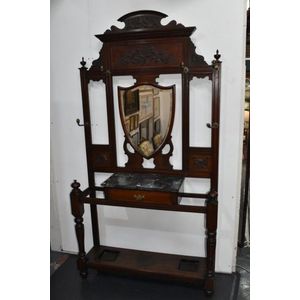Cast iron is produced by heating iron with a high carbon content until it liquefies, and then casting the iron into moulds of compressed sand.
Cast iron was invented in China in the 5th century BC and poured into moulds to make ploughshares and pots as well as weapons and pagodas. Although steel had been invented, was in use, and was more desirable, cast iron was cheaper and thus was more commonly used for warfare in ancient China.
In the west, cast iron did not become available until the 15th century, and its earliest uses included cannon and shot, and
more...
later, cast iron cannons, which, while heavier than the existing bronze cannons, were much cheaper to manufacture and enabled more to be produced..
Cast iron pots were made at many English blast furnaces from about the 17th century. In 1707, Abraham Darby patented a method of making pots and kettles thinner and thus cheaper than his rivals could. This meant that his Coalbrookdale furnaces became dominant as suppliers of pots, an activity in which they were joined in the 1720s and 1730s by a small number of other coke-fired blast furnaces.
The ability to manufacture lighter items led to the popularity of cast iron for furniture and garden decoration during the 19th century, of which the Coalbrookdale company was the leading exponent.
Wrought iron became very popular again in the 1920s during the Art Deco period, and its uses included chairs, firescreens, decorative lamps and legs for tables.
Wrought iron differs from cast iron in that articles made from it cannot be mass produced. Each piece must be individually made (wrought) using a hammer on an anvil and a blacksmith's forge.
less...
A 19th century innovation, the earliest hallstands usually consisted of a straight or shaped upright, sometimes with a drawer and with rounded wooden pegs or hooks on which to hang coats and hats. Some versions also contained umbrella stands, eith in the central section or to each side.
Hallstands became proportionately larger during the course of the century, sometimes being equipped with lift up seats and arms, and later models had brass hooks that tended to replace the wooden knobs. Early versions were usually wooden, although wonderful cast iron hallstands are to be found from the middle of the century,
more...
richly cast and ornamented.
The best known manufacturer of cast iron hallstands was Coalbrookdale Company of Shropshire England, founded in 1709. In the 1840s the company developed a range of cast iron furniture, which, once the moulds had been created, could be mass produced. Coalbookdale items are marked either with the full name of the company or an abbreviation such as 'C-B-DALE Co'
Cast iron hallstands will often also include the date lozenge, often cast into the base of the drip trays indicating the year in which the design was registered.
Some were made in Australia featuring native plants as their dominant motifs.
Towards the end of the century, hallstands were made in bamboo and lacquer work in the Japanese taste. Hallstands continued in fashion until the 1920s and were sometimes made in the prevailing Jacobean revival fashion or the plainer styles inspired by the Arts and Crafts Movement.
A variant on the hallstand is the hall tree, usually made of timber with a central stem and three or so arching branches to each side, fitted with knobs or hooks for coats and jackets.
Another variant is the umbrella or stick stand, usually about waist height or lower, in cast iron, with a loop in the upper section and a drip tray below to hold the walking sticks, canes or umbrellas. The backs are sometimes cast in the form of animals, testifying to their connection to the great outdoors.
less...







 Loading more...
Loading more...